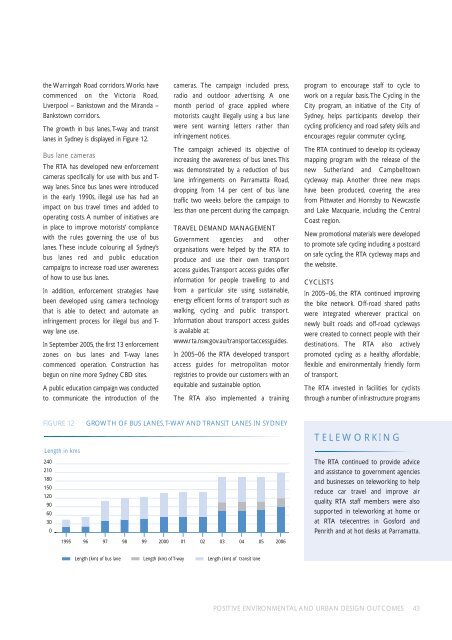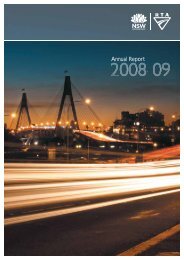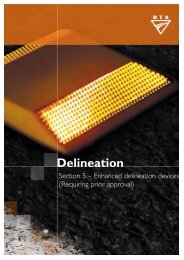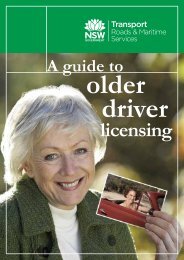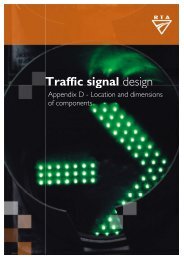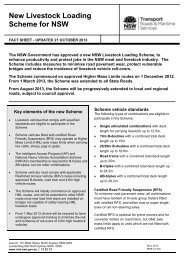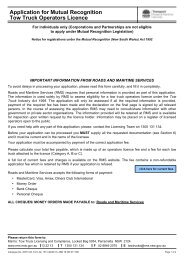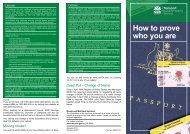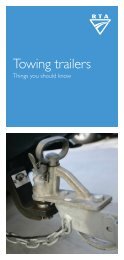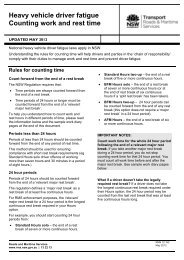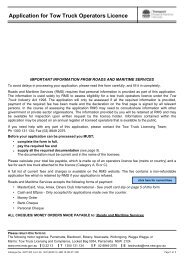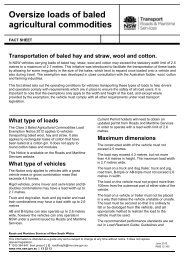Annual Report 2006 (main body) - RTA - NSW Government
Annual Report 2006 (main body) - RTA - NSW Government
Annual Report 2006 (main body) - RTA - NSW Government
Create successful ePaper yourself
Turn your PDF publications into a flip-book with our unique Google optimized e-Paper software.
the Warringah Road corridors.Works have<br />
commenced on the Victoria Road,<br />
Liverpool – Bankstown and the Miranda –<br />
Bankstown corridors.<br />
The growth in bus lanes, T-way and transit<br />
lanes in Sydney is displayed in Figure 12.<br />
Bus lane cameras<br />
The <strong>RTA</strong> has developed new enforcement<br />
cameras specifically for use with bus and T-<br />
way lanes. Since bus lanes were introduced<br />
in the early 1990s, illegal use has had an<br />
impact on bus travel times and added to<br />
operating costs. A number of initiatives are<br />
in place to improve motorists’ compliance<br />
with the rules governing the use of bus<br />
lanes. These include colouring all Sydney’s<br />
bus lanes red and public education<br />
campaigns to increase road user awareness<br />
of how to use bus lanes.<br />
In addition, enforcement strategies have<br />
been developed using camera technology<br />
that is able to detect and automate an<br />
infringement process for illegal bus and T-<br />
way lane use.<br />
In September 2005, the first 13 enforcement<br />
zones on bus lanes and T-way lanes<br />
commenced operation. Construction has<br />
begun on nine more Sydney CBD sites.<br />
A public education campaign was conducted<br />
to communicate the introduction of the<br />
cameras. The campaign included press,<br />
radio and outdoor advertising. A one<br />
month period of grace applied where<br />
motorists caught illegally using a bus lane<br />
were sent warning letters rather than<br />
infringement notices.<br />
The campaign achieved its objective of<br />
increasing the awareness of bus lanes. This<br />
was demonstrated by a reduction of bus<br />
lane infringements on Parramatta Road,<br />
dropping from 14 per cent of bus lane<br />
traffic two weeks before the campaign to<br />
less than one percent during the campaign.<br />
TRAVEL DEMAND MANAGEMENT<br />
<strong>Government</strong> agencies and other<br />
organisations were helped by the <strong>RTA</strong> to<br />
produce and use their own transport<br />
access guides.Transport access guides offer<br />
information for people travelling to and<br />
from a particular site using sustainable,<br />
energy efficient forms of transport such as<br />
walking, cycling and public transport.<br />
Information about transport access guides<br />
is available at:<br />
www.rta.nsw.gov.au/transportaccessguides.<br />
In 2005–06 the <strong>RTA</strong> developed transport<br />
access guides for metropolitan motor<br />
registries to provide our customers with an<br />
equitable and sustainable option.<br />
The <strong>RTA</strong> also implemented a training<br />
program to encourage staff to cycle to<br />
work on a regular basis.The Cycling in the<br />
City program, an initiative of the City of<br />
Sydney, helps participants develop their<br />
cycling proficiency and road safety skills and<br />
encourages regular commuter cycling.<br />
The <strong>RTA</strong> continued to develop its cycleway<br />
mapping program with the release of the<br />
new Sutherland and Campbelltown<br />
cycleway map. Another three new maps<br />
have been produced, covering the area<br />
from Pittwater and Hornsby to Newcastle<br />
and Lake Macquarie, including the Central<br />
Coast region.<br />
New promotional materials were developed<br />
to promote safe cycling including a postcard<br />
on safe cycling, the <strong>RTA</strong> cycleway maps and<br />
the website.<br />
CYCLISTS<br />
In 2005–06, the <strong>RTA</strong> continued improving<br />
the bike network. Off-road shared paths<br />
were integrated wherever practical on<br />
newly built roads and off-road cycleways<br />
were created to connect people with their<br />
destinations. The <strong>RTA</strong> also actively<br />
promoted cycling as a healthy, affordable,<br />
flexible and environmentally friendly form<br />
of transport.<br />
The <strong>RTA</strong> invested in facilities for cyclists<br />
through a number of infrastructure programs<br />
FIGURE 12<br />
Length in kms<br />
240<br />
210<br />
180<br />
150<br />
120<br />
90<br />
60<br />
30<br />
0<br />
GROWTH OF BUS LANES,T-WAY AND TRANSIT LANES IN SYDNEY<br />
TELEWORKING<br />
The <strong>RTA</strong> continued to provide advice<br />
and assistance to government agencies<br />
and businesses on teleworking to help<br />
reduce car travel and improve air<br />
quality. <strong>RTA</strong> staff members were also<br />
supported in teleworking at home or<br />
at <strong>RTA</strong> telecentres in Gosford and<br />
Penrith and at hot desks at Parramatta.<br />
1995 96 97 98 99 2000 01 02 03 04 05 <strong>2006</strong><br />
Length (km) of bus lane Length (km) of T-way Length (km) of transit lane<br />
POSITIVE ENVIRONMENTAL AND URBAN DESIGN OUTCOMES 43


